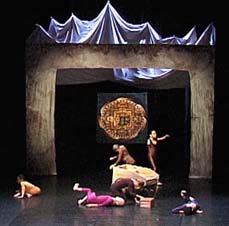The Legend of Maha-Laba Village
written and directed by Manri Kim
The Legend of Maha-Laba Villagewritten and directed by Manri Kim |
 |
|
"Maha-Laba Mura" (Maha-Laba village) was a commune of people with cerebral palsy; this commune existed in Ibaragi prefecture in Japan from the mid to late 1960s. (Note: "Maha-Laba) The conditions and experiences in this isolated commune led to the development of the ideas and policies of the Blue-Lawn Party. This party led an intense liberation movement of disabled people in the 1970s. Their political action plan said:
The party's beliefs and actions were a challenge directed toward the value system of non-disabled society and its eugenic ideology. The party's intensity was a shock to the non-disabled world, but the movement collapsed before long. (Note: "Blue-lawn party" movemants and TAIHEN)
The piece is not a historical account of the Maha-Laba village or the Blue Lawn Party.
TAIHEN's stage works are without words. The works are "physical theatre" in which physically disabled performers try to turn their distorted bodies and ungainly movement into symbolic expression.
| ||||
|
[Notes]
* Maha-Laba : The Sanskrit "Maha"
means "great", and "Laba" means "cry".
[return]
* "Blue Lawn Party" movements and TAIHEN : Manri KIM, artistic director of TAIHEN, was once a member of BLP, but she left because it could not find a path of creation and construction, the next stage which should follow the destructive energy of antithesis. She turned to physical arts in which she directs questions to the "ordinary" aesthetics.